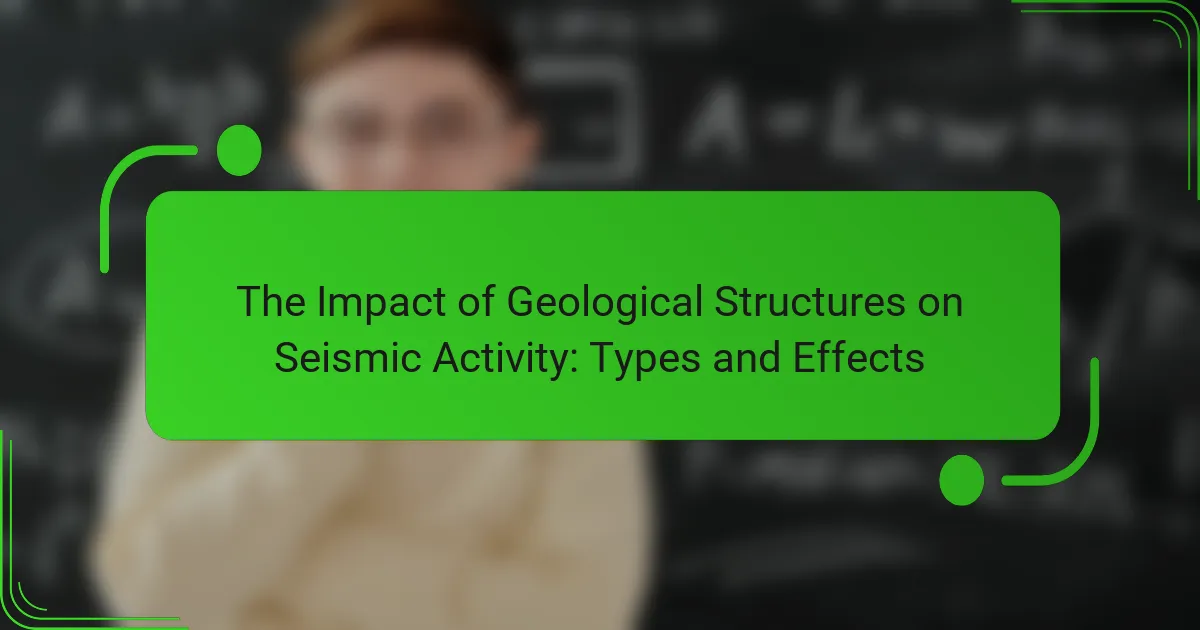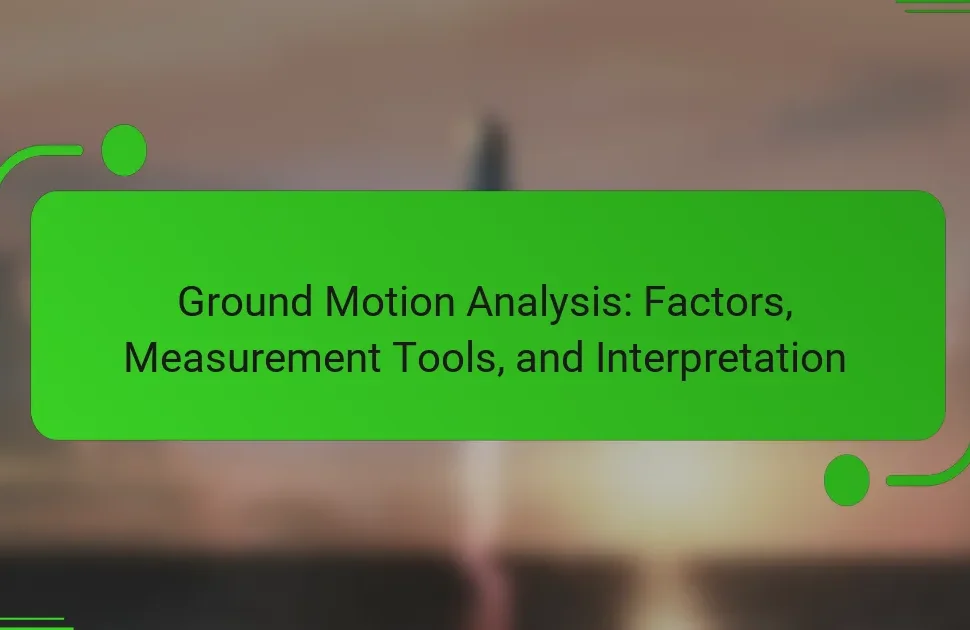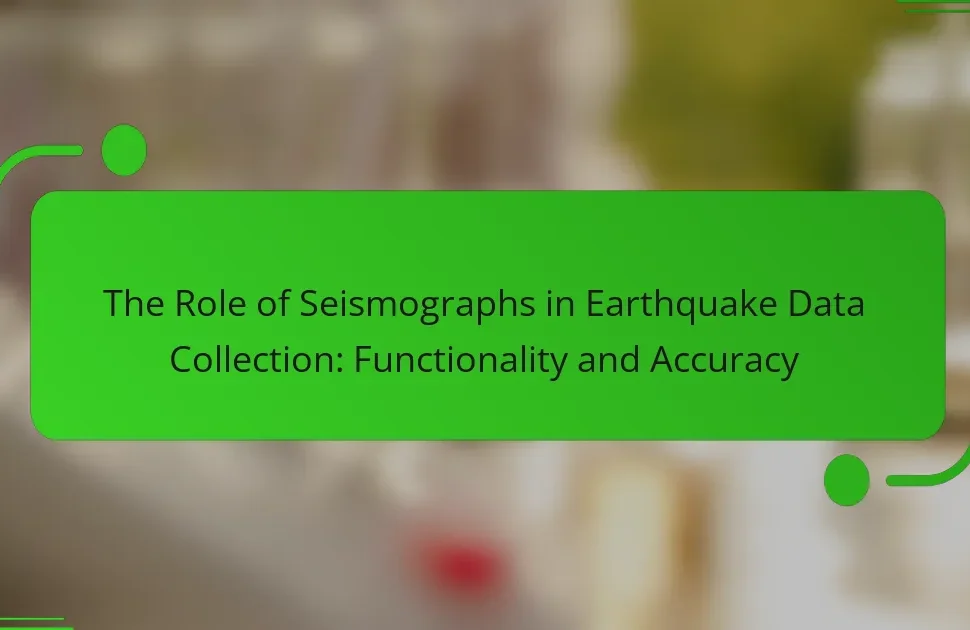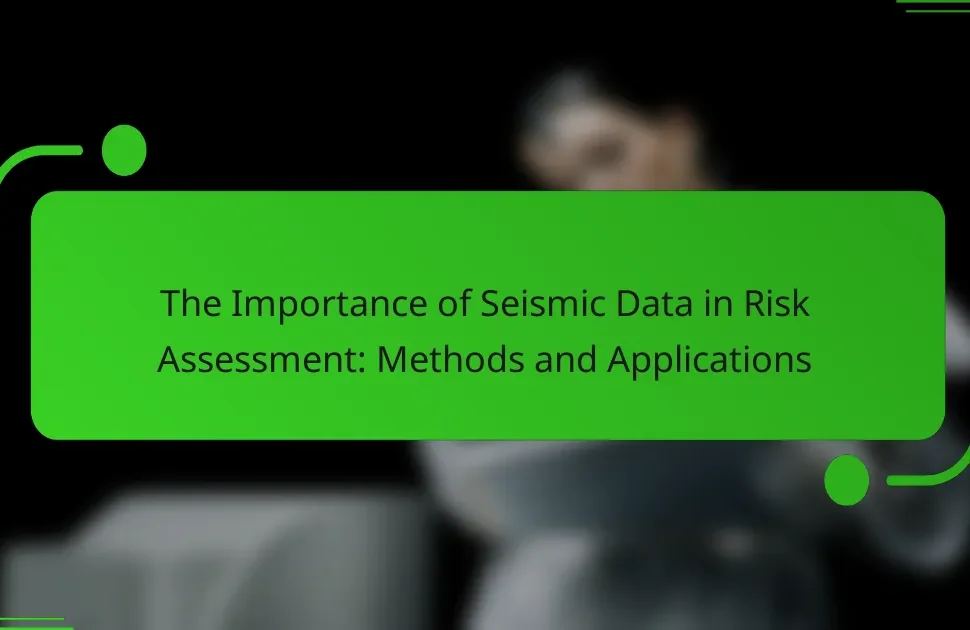Geological structures, including faults, folds, and rock layers, play a crucial role in influencing seismic activity. Faults are fractures in the Earth’s crust where movement occurs, often leading to earthquakes, while folds are bends in rock layers resulting from tectonic forces. The interaction of these structures can lead to stress accumulation, which, when exceeded, results in seismic events. Notable examples include the San Andreas Fault, which is known for its significant seismic activity. Understanding these geological formations is essential for predicting and mitigating earthquake risks, as they also affect stress distribution and can amplify seismic waves, thereby increasing the intensity of earthquakes.
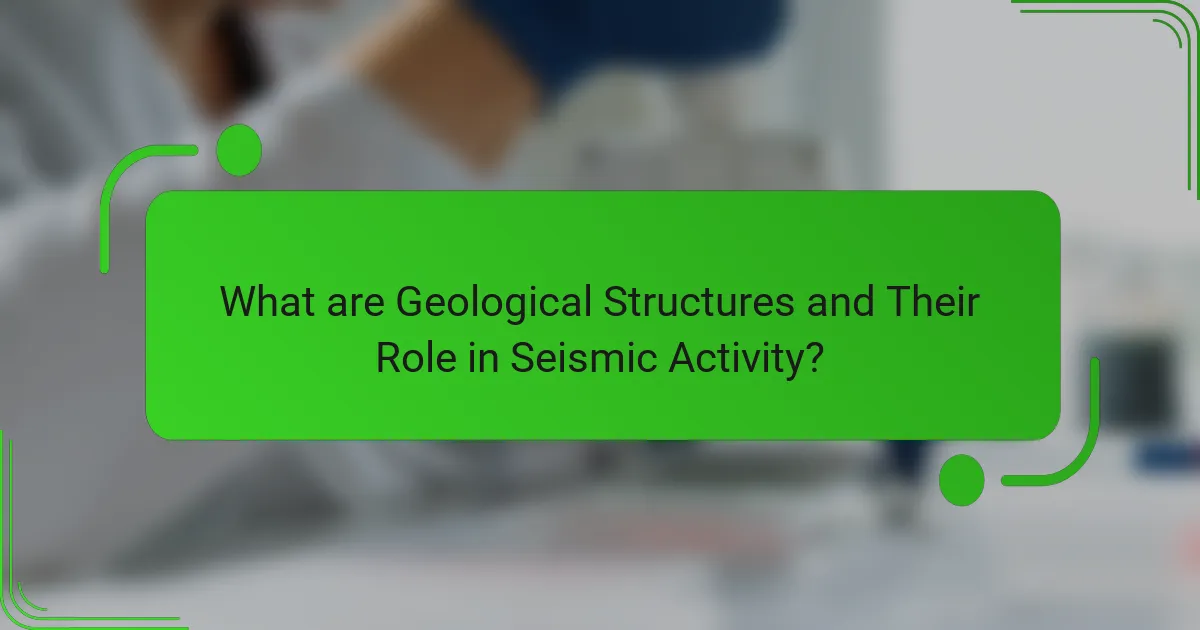
What are Geological Structures and Their Role in Seismic Activity?
Geological structures are formations in the Earth’s crust that influence seismic activity. These structures include faults, folds, and rock layers. Faults are fractures where movement has occurred, leading to earthquakes. Folds are bends in rock layers caused by tectonic forces. The interaction of these structures can generate stress accumulation. When the stress exceeds the strength of the rocks, it results in seismic events. For instance, the San Andreas Fault is a well-known geological structure that produces significant seismic activity. Understanding these structures helps in predicting and mitigating earthquake risks.
How do geological structures influence the occurrence of seismic events?
Geological structures significantly influence the occurrence of seismic events. These structures include faults, folds, and tectonic plate boundaries. Faults are fractures in the Earth’s crust where movement has occurred. They can store elastic energy, which is released as seismic waves during an earthquake. Tectonic plate boundaries are particularly active regions. They are classified into convergent, divergent, and transform boundaries, each associated with different seismic activities. For example, convergent boundaries often lead to powerful earthquakes due to subduction processes. Historical data shows that over 90% of seismic events occur along these plate boundaries. Understanding these geological structures helps predict the likelihood and intensity of seismic events.
What types of geological structures are most commonly associated with seismic activity?
The types of geological structures most commonly associated with seismic activity include fault lines, tectonic plates, and volcanic regions. Fault lines are fractures in the Earth’s crust where movement has occurred. They often experience earthquakes due to accumulated stress. Tectonic plates are large sections of the Earth’s crust that float on the semi-fluid mantle. Their interactions at plate boundaries lead to seismic events. Volcanic regions are associated with magma movement and can produce earthquakes as magma forces its way to the surface. Historical data shows that regions along the Pacific Ring of Fire frequently experience seismic activity due to these geological structures.
How do geological formations affect the propagation of seismic waves?
Geological formations significantly influence the propagation of seismic waves. Different materials in the Earth’s crust, such as rock types and soil compositions, affect wave speed and amplitude. Harder materials, like granite, transmit seismic waves faster than softer materials, such as clay. This variation in speed leads to changes in wave direction and intensity. Geological structures, like faults and folds, can also reflect and refract seismic waves. For instance, waves may bend when passing from one type of rock to another. The presence of water-saturated layers can further slow down wave propagation. Studies show that seismic waves can lose energy when traveling through heterogeneous geological formations. This loss can lead to weaker ground shaking in certain areas.
Why is understanding geological structures important for earthquake prediction?
Understanding geological structures is crucial for earthquake prediction because they dictate the behavior of tectonic plates. These structures include faults, folds, and rock types that influence stress accumulation. By analyzing these geological features, scientists can identify areas with a higher likelihood of seismic activity. Historical data shows that regions with well-defined fault lines experience more frequent earthquakes. For instance, the San Andreas Fault in California is a prime example of this relationship. Monitoring geological changes can provide early warning signs of potential earthquakes. Therefore, a thorough understanding of geological structures enhances predictive models and improves safety measures.
What methods are used to study geological structures in relation to seismic activity?
Geological structures are studied in relation to seismic activity using various methods. These methods include seismic reflection and refraction techniques. Seismographs record ground motion during earthquakes. Geophysical surveys analyze subsurface structures through magnetic and gravitational data. Remote sensing technologies, such as satellite imagery, monitor surface changes. Geological mapping provides insights into rock formations and fault lines. Laboratory experiments simulate seismic conditions to study material behavior. Each of these methods contributes to understanding how geological structures influence seismic events.
How can geological mapping improve seismic risk assessments?
Geological mapping enhances seismic risk assessments by providing detailed information about subsurface structures. This information helps identify fault lines, soil types, and rock formations. Accurate mapping reveals areas more susceptible to seismic activity. It allows for the assessment of ground shaking potential in different regions. Geological maps can show historical earthquake patterns, aiding in predicting future risks. Studies indicate that integrating geological data with seismic models improves risk evaluation accuracy. For instance, the US Geological Survey utilizes geological mapping to inform the ShakeMap system, which assesses ground shaking after an earthquake. This integration leads to better preparedness and mitigation strategies.
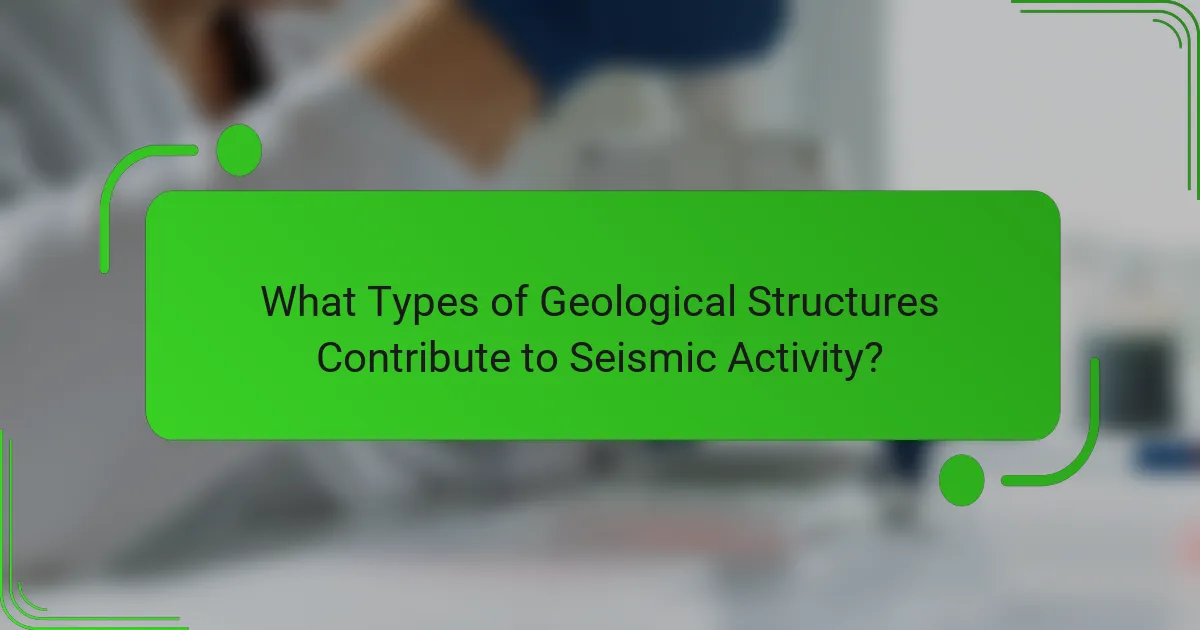
What Types of Geological Structures Contribute to Seismic Activity?
Faults, subduction zones, and volcanic structures contribute to seismic activity. Faults are fractures in the Earth’s crust where movement occurs. They often release accumulated stress, causing earthquakes. Subduction zones occur where one tectonic plate moves under another. This interaction generates significant seismic events due to the intense pressure and friction. Volcanic structures can also induce seismic activity. Earthquakes may occur during volcanic eruptions as magma shifts underground. Each of these geological structures plays a critical role in the dynamics of seismic events.
What are the main types of geological structures related to earthquakes?
The main types of geological structures related to earthquakes are faults, folds, and volcanic structures. Faults are fractures in the Earth’s crust where blocks of rock have moved relative to each other. They are the primary cause of earthquakes, with significant fault systems like the San Andreas Fault in California. Folds occur when rock layers are compressed, causing them to bend. They can store potential energy that may be released as seismic waves during an earthquake. Volcanic structures, such as calderas and magma chambers, can also be associated with earthquakes. These structures can generate seismic activity through the movement of magma and tectonic forces.
How do faults contribute to seismic events?
Faults contribute to seismic events by storing elastic energy that is released during an earthquake. When tectonic plates move, they can become locked along fault lines. Stress builds up as the plates continue to push against each other. Once the stress exceeds the strength of the rocks, it causes a sudden slip along the fault. This slip generates seismic waves, which we feel as earthquakes. According to the United States Geological Survey, about 90% of earthquakes occur along faults. The magnitude of the seismic event correlates with the amount of stored energy released during the slip.
What role do folds and fractures play in seismic activity?
Folds and fractures are critical in the generation of seismic activity. Folds occur when rock layers are compressed, leading to the bending of strata. This can create stress that, when released, results in earthquakes. Fractures, or faults, are breaks in the Earth’s crust where movement has occurred. They allow for the accumulation of stress over time. When the stress exceeds the strength of the rocks, it results in a sudden release of energy, causing seismic waves. The 2011 Tōhoku earthquake in Japan is an example where fault movement triggered significant seismic activity. Both folds and fractures thus serve as essential mechanisms facilitating the release of tectonic stress, resulting in earthquakes.
How do tectonic plates influence seismic activity through geological structures?
Tectonic plates influence seismic activity by interacting at their boundaries. These interactions create geological structures such as faults, ridges, and trenches. When plates collide, they can cause stress to build up in the Earth’s crust. This stress eventually releases as seismic waves, resulting in earthquakes. For example, the San Andreas Fault in California is a transform boundary where two plates slide past each other. The friction at this fault line leads to significant seismic activity. Similarly, convergent boundaries, like the one between the Pacific and North American plates, create subduction zones that produce powerful earthquakes. Historical data shows that over 90% of the world’s earthquakes occur along tectonic plate boundaries. This demonstrates the direct link between tectonic activity and seismic events.
What are the interactions between tectonic plates and geological formations?
Tectonic plates interact with geological formations through processes such as subduction, collision, and rifting. These interactions lead to the formation of mountains, earthquakes, and volcanic activity. For example, the Himalayas formed from the collision of the Indian and Eurasian plates. Subduction zones, like the Cascadia Subduction Zone, create deep ocean trenches and volcanic arcs. Rifting occurs when tectonic plates pull apart, forming features like the East African Rift. The movement of these plates causes stress accumulation in geological formations, which can result in seismic activity. Historical data shows that over 80% of the world’s earthquakes occur along plate boundaries.
How do subduction zones create seismic hazards?
Subduction zones create seismic hazards through the process of tectonic plate interaction. In these zones, one tectonic plate is forced beneath another. This subduction causes intense pressure to build up over time. When the stress exceeds the strength of rocks, it results in an earthquake. Earthquakes in subduction zones can be very powerful. For example, the 2004 Indian Ocean earthquake had a magnitude of 9.1. These earthquakes can also trigger tsunamis, which pose additional hazards. The movement of the plates can lead to volcanic activity as well. Subduction zones are thus critical areas for assessing seismic risk.

What Are the Effects of Geological Structures on Seismic Activity?
Geological structures significantly influence seismic activity. These structures include faults, folds, and rock layers. They determine the stress distribution within the Earth’s crust. When stress exceeds the strength of rocks, earthquakes occur. For example, the San Andreas Fault is a well-known geological structure that produces frequent seismic events. The interaction between tectonic plates at these faults leads to energy release. Additionally, geological formations can amplify seismic waves, increasing the intensity of earthquakes. Studies show that regions with complex geological structures experience more seismic activity. This relationship is critical for understanding earthquake risks and planning mitigation strategies.
How do geological structures affect the magnitude and intensity of earthquakes?
Geological structures significantly influence the magnitude and intensity of earthquakes. These structures include faults, tectonic plate boundaries, and rock types. Faults are fractures in the Earth’s crust where movement occurs. The amount of stress accumulated along these faults determines the potential energy released during an earthquake. Different rock types have varying strengths and elastic properties. Stronger rocks can store more energy before failing, leading to higher magnitude earthquakes.
Tectonic plate boundaries are critical in this process. Convergent boundaries often produce more intense earthquakes due to the collision of plates. Divergent boundaries typically result in lower magnitude earthquakes. Transform boundaries can generate significant earthquakes as plates slide past each other.
Historical data supports these observations. The 1906 San Francisco earthquake occurred along the San Andreas Fault, demonstrating the relationship between geological structures and seismic events. Research shows that regions with complex geological structures experience more frequent and intense earthquakes.
What is the relationship between the depth of geological structures and seismic impact?
The depth of geological structures significantly influences seismic impact. Deeper geological formations can absorb and dampen seismic waves more effectively than shallower ones. This results in lower surface shaking intensity during seismic events. For instance, studies show that seismic waves traveling through deeper materials experience more attenuation. According to research by the United States Geological Survey, seismic waves can lose energy due to scattering and absorption in deeper layers. Therefore, the relationship between depth and seismic impact is critical for understanding earthquake effects on the surface.
How do geological conditions influence aftershock patterns?
Geological conditions significantly influence aftershock patterns. The type of fault, rock properties, and surrounding geological structures determine how aftershocks occur. For instance, a strike-slip fault often produces a different aftershock sequence compared to a thrust fault. The rigidity of surrounding rocks can affect the energy release during aftershocks. Additionally, geological features like sedimentary basins can amplify seismic waves, altering aftershock intensity. Studies show that regions with complex geology experience more varied aftershock patterns. For example, the 2010 Haiti earthquake demonstrated diverse aftershock behavior due to the underlying geological complexity. Understanding these conditions helps in predicting aftershock occurrences effectively.
What are the implications of geological structures for urban planning and safety?
Geological structures significantly influence urban planning and safety. They determine the suitability of land for construction and infrastructure. For example, areas with unstable soil or fault lines pose risks for buildings during seismic events. Urban planners must assess geological surveys to identify these risks. This assessment helps in designing structures that can withstand earthquakes. Additionally, geological features affect water drainage and flood risks. Poor drainage can lead to urban flooding, impacting safety. Therefore, understanding geological structures is essential for sustainable urban development. Accurate geological mapping supports informed decision-making in urban planning.
How can knowledge of local geological structures enhance building codes?
Knowledge of local geological structures can enhance building codes by ensuring they are tailored to specific seismic risks. Understanding the geological composition helps identify areas prone to earthquakes or landslides. This information allows for the development of codes that mandate appropriate design and materials. For instance, regions with soft soil may require deeper foundations. Conversely, areas with stable bedrock can support different structural designs. Historical data shows that buildings designed with geological insights suffer less damage during seismic events. For example, the 1994 Northridge earthquake highlighted the importance of considering local geology in building regulations. Adapting codes based on geological knowledge ultimately improves public safety and reduces economic losses.
What strategies can communities implement to mitigate seismic risks associated with geological structures?
Communities can implement several strategies to mitigate seismic risks associated with geological structures. These strategies include conducting geological assessments to identify risk-prone areas. Communities should also enforce strict building codes that require earthquake-resistant designs. Regular earthquake drills help prepare residents for seismic events. Investing in early warning systems can provide crucial alerts before an earthquake strikes. Additionally, retrofitting existing buildings enhances their resilience to seismic forces. Public education campaigns can raise awareness about earthquake preparedness. Finally, land-use planning should avoid construction in high-risk zones. These strategies collectively reduce vulnerability and enhance community safety during seismic events.
What best practices should be followed in studying geological structures for seismic assessment?
Best practices in studying geological structures for seismic assessment include detailed geological mapping and characterization. This process involves identifying rock types, faults, and folds. Utilizing geophysical methods enhances subsurface imaging. Techniques like seismic reflection and refraction are commonly employed. Conducting site-specific seismic hazard assessments is crucial. These assessments evaluate potential ground shaking and liquefaction risks. Implementing continuous monitoring systems can provide real-time data. This data aids in understanding seismic behavior over time. Collaboration with interdisciplinary teams ensures comprehensive evaluations. These teams may include geologists, seismologists, and engineers.
The main entity of this article is geological structures and their impact on seismic activity. It provides an overview of how various geological formations, including faults, folds, and tectonic plate boundaries, influence the occurrence and intensity of earthquakes. The article discusses the mechanisms by which geological structures contribute to stress accumulation and the release of seismic energy, as well as the methods used to study these structures. Additionally, it addresses the implications of understanding geological formations for earthquake prediction, urban planning, and community safety, highlighting best practices for seismic assessments.
